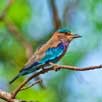National parks
© Copyright 2024-25 by GTI Travels Pvt. Ltd.
With the rugged, rocky and deciduous forest of Ranthambore is not famous only in India but in the world for its amazing Tigers which inhibit the forest. Being the home to some of the most celebrated tigers in the world, the Ranthambore National Park is among the most visited parks on this earth. from all over the world to explore the forest and to add a memorable adventure experience in their lives.

The Ranthambore National Park has been the proud habitat of the tigress Machli who was the most photographed and most documented tiger in the world till she was alive. The park drew its name from the highly acclaimed fort located inside the park named Ranthambore Fort which is also a UNESCO world heritage site. Spread in the total area of around 1334 sq km with the core area of around 392 sq km, the park boasts of its large number of amazingly diverse flora and fauna that draw a huge crowd of wildlife enthusiasts from all over the world to explore the forest and to add a memorable adventure experience in their lives.

Situated on the large plateau on the confluence of the Aravali Range and the Vindhya Range of hills, the forest of the Ranthambore was the Royal hunting forest for the members of the Royal family of Jaipur before the Imperialism abolished in India and the forest taken over by the forest department of India. The Ranthambore National Park holds a prominent historic value in India due to the ancient ruins and structures present in the forest which are preserved by the government. The mighty Fort of Ranthambore is an attraction for the visitors of the park, which is located on the top of a hill and offers the panoramic view of the forest from the terrace of the Fort. The ancient temple of Lord Ganesha which is situated at the entrance of the Fort is the only temple of TrinetraGanesha and holds a prominent religious value for the devotees.

The Ranthambore Park is situated in the heritage town of SawaiMadhopuraround 11 km away from the city offering the complete tranquillity and closeness to the pure Nature. The jagged landscape of the Ranthambore forest is flanked by the two rivers the Banas River in the North and the Chambal River in the south. The forest comprises of the sharp rocky terrain, valleys, riverine, lakes, waterholes, dusty paths and short shrubby and deciduous trees which make the perfect ambiance of the raw forest and provide habitat for a large number of wild animals, birds and reptiles. The fauna of Ranthambore primarily include the Royal Bengal Tigers, Leopards, Sloth Bears, Wild Boars, Hyena, Langurs, Nilgai, various species of Deer and many others along with more than 320 species of exotic birds and around 40 different species of reptiles. Marsh Crocodile is among the famous reptiles which are prominently seen in the lakes of Ranthambore forest.

The Ranthambore National Park is widely known for getting the best sighting of the most dangerous wild animal, the Royal Bengal Tiger since the forest is designated as the Tiger Reserve forest. The tiger population increased pertinently since then, which makes this forest one of the highest tiger density forest in India. Due to being a deciduous forest and having the small trees as its vegetation cover, one can easily spot the wild animals from the distance making it the most visited tiger reserve forest for the sighting of the Tiger. The forest authority offers the exploration of the forest by organizing the Jeep Safari and the Canter Safari everyday in the two shifts for the wildlife enthusiasts. The park is divided into the ten ecotourism zone and every zone is the territory of the various celebrated Tigers of Ranthambore. Visitors to the park can spot the tigers roaming with grandeur or lazily sitting on the Safari tracks or chasing its prey in their natural habitat.

The ecotourism zones of the Ranthambore National Park remain open from 1st October to 30th June of every year and remain closed from 1st July to 30th September during the monsoon season. Due to being the desert locality, the Ranthambore National Park has the subtropical arid weather and the temperature goes very high in the summer season. The temperature crosses 45 degrees Celsius in the months of May and June which makes it hard to venture out in the daytime.

The best time to visit the Ranthambore National Park is from October to April except for the few days of bitter cold in the winter season. While summer is hot and it's hard to withstand the heat of the scorching sun rays, the chance of spotting a tiger is higher in this season around the lakes and water bodies in the park. You can visit even in the summer season, but fully prepared to combat the harsh sunlight and high temperature. Whether you visit in the summer season or the winter season, always pack the luggage according to the season for your tour.